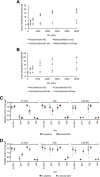Early emergence of negative regulation of the tyrosine kinase Src by the C-terminal Src kinase
- PMID: 28939764
- PMCID: PMC5682962
- DOI: 10.1074/jbc.M117.811174
Early emergence of negative regulation of the tyrosine kinase Src by the C-terminal Src kinase
Abstract
Stringent regulation of tyrosine kinase activity is essential for normal cellular function. In humans, the tyrosine kinase Src is inhibited via phosphorylation of its C-terminal tail by another kinase, C-terminal Src kinase (Csk). Although Src and Csk orthologs are present across holozoan organisms, including animals and protists, the Csk-Src negative regulatory mechanism appears to have evolved gradually. For example, in choanoflagellates, Src and Csk are both active, but the negative regulatory mechanism is reportedly absent. In filastereans, a protist clade closely related to choanoflagellates, Src is active, but Csk is apparently inactive. In this study, we use a combination of bioinformatics, in vitro kinase assays, and yeast-based growth assays to characterize holozoan Src and Csk orthologs. We show that, despite appreciable differences in domain architecture, Csk from Corallochytrium limacisporum, a highly diverged holozoan marine protist, is active and can inhibit Src. However, in comparison with other Csk orthologs, Corallochytrium Csk displays broad substrate specificity and inhibits Src in an activity-independent manner. Furthermore, in contrast to previous studies, we show that Csk from the filasterean Capsaspora owczarzaki is active and that the Csk-Src negative regulatory mechanism is present in Csk and Src proteins from C. owczarzaki and the choanoflagellate Monosiga brevicollis Our results suggest that negative regulation of Src by Csk is more ancient than previously thought and that it might be conserved across all holozoan species.
Keywords: inhibition mechanism; molecular biology; non-receptor tyrosine kinase (nRTK); protein evolution; protein phosphorylation.
© 2017 by The American Society for Biochemistry and Molecular Biology, Inc.
Conflict of interest statement
The authors declare that they have no conflicts of interest with the contents of this article. The content is solely the responsibility of the authors and does not necessarily represent the official views of the National Institutes of Health
Figures





References
-
- Hunter T., and Cooper J. A. (1985) Protein-tyrosine kinases. Annu. Rev. Biochem. 54, 897–930 - PubMed
-
- Hanks S. K., and Hunter T. (1995) Protein kinases 6: the eukaryotic protein kinase superfamily: kinase (catalytic) domain structure and classification. FASEB J. 9, 576–596 - PubMed
-
- Miranda-Saavedra D., and Barton G. J. (2007) Classification and functional annotation of eukaryotic protein kinases. Proteins 68, 893–914 - PubMed
Publication types
MeSH terms
Substances
Associated data
- Actions
- Actions
Grants and funding
LinkOut - more resources
Full Text Sources
Other Literature Sources
Miscellaneous

